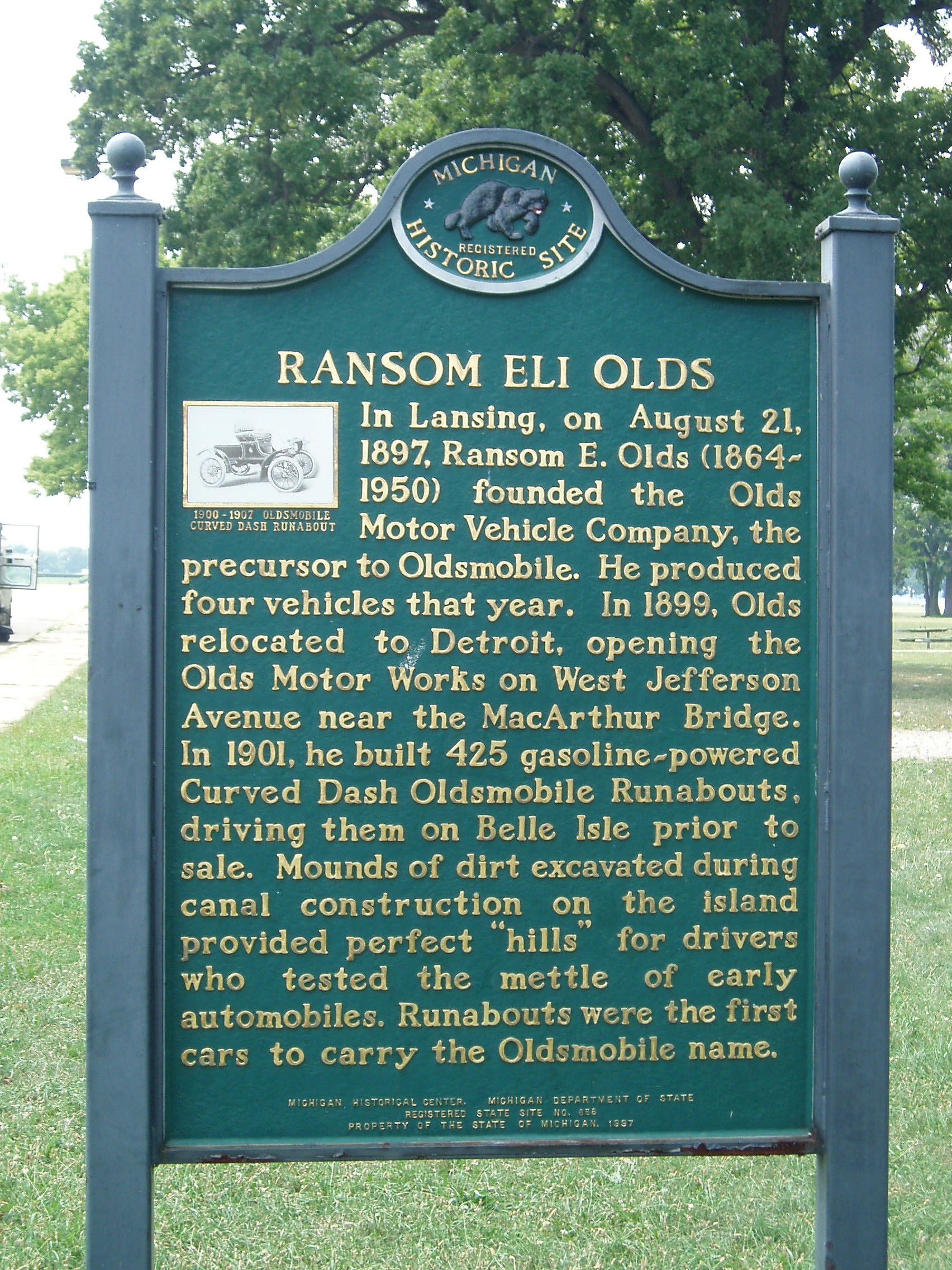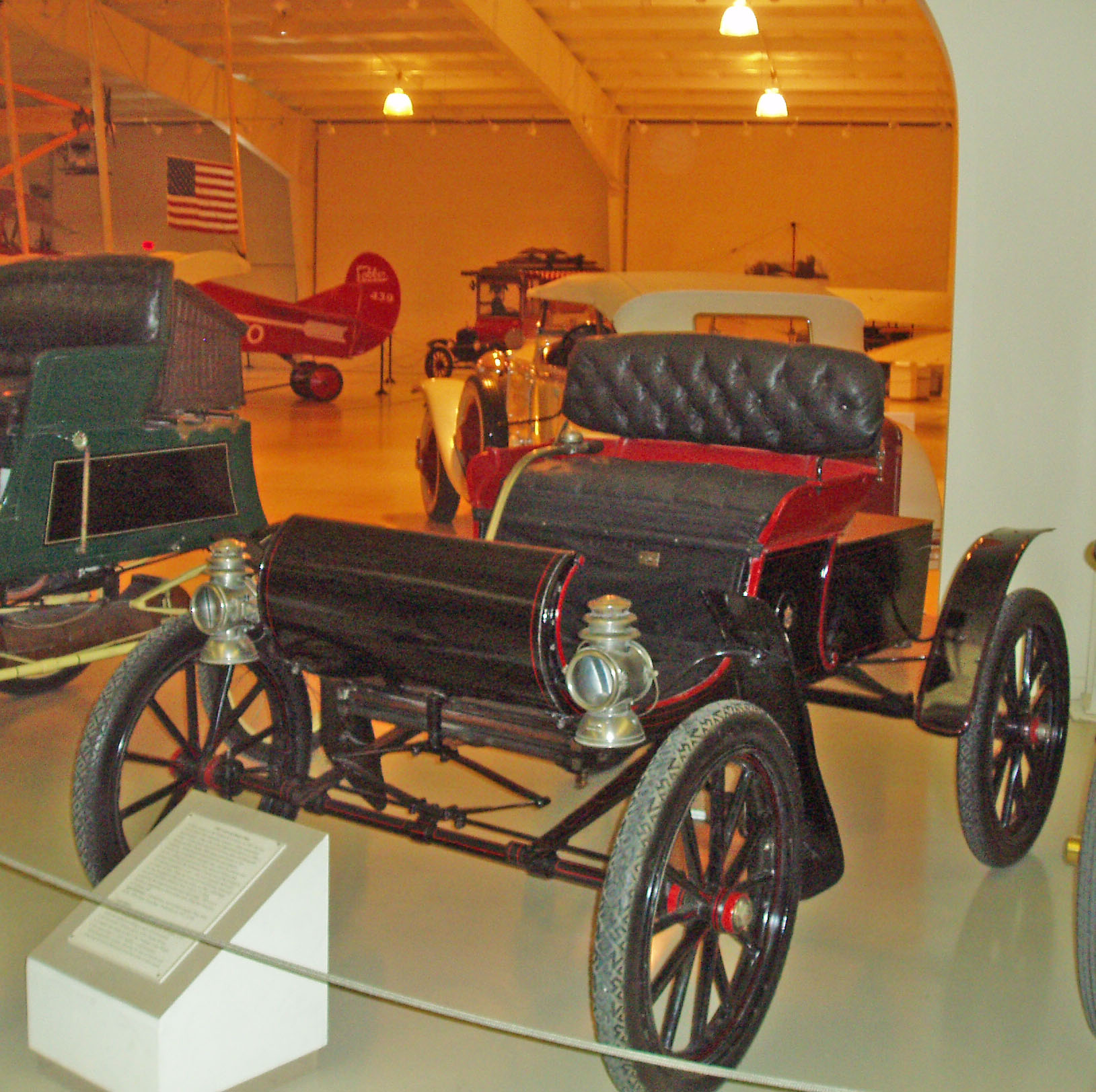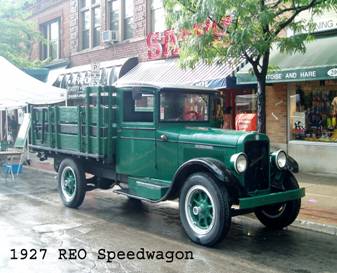
Ransom Eli Olds Commemorative Marker
On the west side of Central Avenue near the intersection of
Central Avenue and Muse on Belle Isle
If you were enumerating key figures whose contributions made Detroit the international automotive capital that it is today, Ransom. E. Olds would rank close to the top of your list. Several years before Henry Ford sold his Model T, Olds manufactured and sold moderately-priced cars built in Detroit in substantial numbers. He was the first to do so.
Olds was born in Geneva, Ohio in 1864. In 1880, his father, Pliny Olds, moved
to Lansing and established a machine shop named P. F. Olds & Son. Ransom
worked with his father as they moved into the production of steam engines
that used gasoline, not coal or wood, as the source of heat. The business
prospered as they turned out large numbers of steam engines for a variety
of purposes. By 1887, Ransom Olds was experimenting with the application
of steam to a road vehicle. His first automobile was completed in that
year, a three-wheeled, one-horsepower, steam-powered machine. Steam, at
this time, effectively powered trains, ships and machines in factories,
but the use of small steam engines to power cars and trucks had not been
perfected. In 1892, Olds built an auto powered by a pa ir of two horsepower
steam engines, each connected to a driving wheel. This worked well on level
ground, but not very well on hills. Ransom Olds attended the Chicago World's
Fair in 1893 and came back to Lansing convinced that road vehicles would
be powered by gasoline engines, not steam. By 1896, he began making
gas-powered cars in Lansing, and on August 21, 1897, he incorporated the
first Michigan
automobile
company: Olds Motor Vehicle.
ir of two horsepower
steam engines, each connected to a driving wheel. This worked well on level
ground, but not very well on hills. Ransom Olds attended the Chicago World's
Fair in 1893 and came back to Lansing convinced that road vehicles would
be powered by gasoline engines, not steam. By 1896, he began making
gas-powered cars in Lansing, and on August 21, 1897, he incorporated the
first Michigan
automobile
company: Olds Motor Vehicle.
Olds developed a reputation for his work in the nascent auto industry. Samuel
L. Smith, a
Detroit capitalist who earned his fortune in Michigan's rich Upper Peninsula
copper deposits and built the lovely Queen Anne house at 5035 Woodward that is
now,
unfortunately, sandwiched against the Macabees Building, sought investment opportunities.
He offered Olds $200,000 to come to Detroit to build cars. Olds accepted the
investment and built Detroit's first auto plant on East Jefferson at Concord,
just to the west of the bridge than linked the mainland to Belle Isle. This substantial
three-story structure was the first building in the world designed for the production
of automobiles. His original vehicles sold relatively well, but were highly priced
at $2,800, putting them out of reach of most prospective customers. In 1900,
Olds realized that he needed to reach a broader audience, so he designed a more
popular car, one that might cost as little as $300 to build and could sell for
$650. This was his lightweight, gasoline powered "curved dash Olds", the
first popular car in this country.
Similar to other early auto manufacturers, Olds assembled parts purchased from
suppliers. Perhaps he built his own 3-horsepower engines at the start, but then
he turned to the Dodge Brothers and. later, to Henry Leland of the Leland and
Falconer machine shop. Because of his skills as a machinist and his insistence
upon accuracy, Henry Leland claimed that the engine he built developed 3.7 horsepower,
even though Olds had designed it for 3 horsepower. Olds' transmissions came from
the Dodge Brothers machine shop; his bodies from the Wilson Body Company and
then from B. F. Everitt. Much excavation was being done on Belle Isle around
1900, so there were many substantial piles of dirt and unpaved trails. According
to lore, new Olds cars were driven from the plant on East Jefferson to Belle
Isle and given a workout before being sold. This explains the location of this
Historic Marker. Robert Szudarek's
book about the automobile industry in Detroit, How Detroit Became the Automobile
Capital,
includes a picture of Roy Chapin—who then worked for Olds, but went on
to found and lead the Hudson
Motor Car Company—driving a "Curved Dash" over
steep piles of dirt on Belle Isle.
Before the Kahn Brothers perfected the use of steel-reinforced concrete, heavy oak was used for flooring in industrial plants. This was a major problem since machines had to be oiled and greased constantly, thereby increasing the risk of fire. Although these early buildings had elaborate protections to prevent the spread of fires, many burned to the ground. Cadillac lost its first plant, and on March 9, 1901, sparks from a welder's torch lit a fire that reduced the Jefferson Avenue Olds plant to ruble. When his plant became ashes, Olds was on vacation at the time visiting his parents who had retired from the steam engine business to San Diego. Lansing investors understood the success of Ransom Olds and put up money for an Olds factory in that city. Ransom Olds found ways to continue production in Detroit, primarily by asking for even more help from his suppliers. Henry Leland was producing the engines for Oldsmobiles at that time. In 1902, Olds produced and sold about 2,500 of the curved dash model. I think that most or all of these were produced at the Leland and Falconer plant located at the corner of Orleans and Trombly neat Milwaukee Junction in Detroit. The following year, Olds production increased to just under 4,000. This was the first highly successful mass produced vehicle in the United States.
Early in 1904, Ransom Olds got into sharp
disagreements with the investors who owned and controlled the firm, even
though he was the innovator and manager. He quit. Shortly thereafter, Lansing
investors attracted the Olds firm back to the state capital. By 1905, it
became part of the General Motors organization that Billy Durant was quickly
assembling. Oldsmobiles were produced by GM in Lansing until 2003 when
this make was discontinued.
Ransom Olds quickly created another vehicle
firm, again in Lansing and again using his own name or initials. He built
REOs in Lansing as early as 1905—a high-quality and relatively expensive
car. Indeed, the 1933 REO was, apparently, the first car to offer customers
an automatic transmission. Production of REO cars continued until 1936
when the Depression finally put an end to their run. REO continued to build
trucks and enjoyed prosperity during World War II and immediately thereafter.
By the 1950s, smaller truck producers in the United States—White,
Divco, Mack, Hudson, Studebaker, Diamond T and REO—had
their survival challenged by the Big Three who had the capital that small
truck firms lacked. The production of REO truck reached the end of the
line in 1955. Another truck producer, Diamond T, merged with REO or bought
their Lansing factories, so trucks were built in the REO plants as recently
as 1973. Ransom E. Olds died at age 86 in 1950.
In Lansing, you will find a Michigan Historical Market commemorating the
second successful—and self named—auto firm that Olds founded,
the REO Motor Car Company. This is located at 1120 Washington. The REO
Buildings in
Lansing were listed on the Michigan Register of Historic Places and designated
as National Historic Landmarks in 1978 but were razed in 1979.
City of Detroit Local Historic District: Not listed
State of Michigan Registry of Historic Sites: P5151, Listed September 24, 1997. The Ransom E. Olds Market was placed on Belle Isle October 24, 1997.
National Register of Historic Places: Belle Isle, listed February 25, 1974
Photograph or Historical Marker: Ren Farley; August, 2005
Photograph of 1902 “Curved Dash”Olds that was, presumably, assembled at the Leland and Falconer plant: Ren Farley: February
20, 2009. This vehicle is a component of the holdings of the Owls Head Transportation Museum in Olds Head, Maine.
Description prepared: February 25, 2009